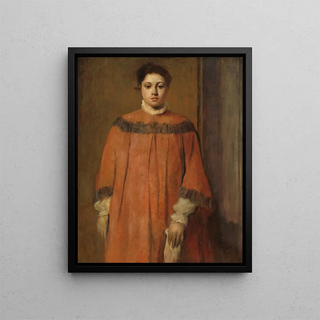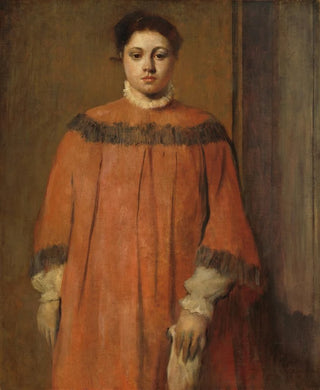Painting Girl in Red - Edgar Degas | Art print


View from behind

Frame (optional)
In the fascinating universe of art, some works stand out for their ability to capture the very essence of life. "Fille en rouge" by Edgar Degas is one of those iconic pieces that transports us to the heart of Impressionism. This painting, imbued with delicacy and movement, highlights the fleeting beauty of a moment. The young girl, dressed in a vibrant red dress, seems to flourish in a world of her own, while inviting us to contemplate the richness of human emotions. Through this artwork, Degas offers us an intimate and poetic vision, where each brushstroke tells a story, a meeting, a moment suspended in time.
Style and uniqueness of the work
Edgar Degas's style is characterized by an exceptional mastery of light and movement, elements that are brilliantly reflected in "Fille en rouge." This piece stands out for its bold use of color, where the vibrant red of the young girl's dress immediately draws the eye. Degas plays with shadows and highlights, creating an atmosphere that is both lively and melancholic. The delicate features of the child's face, combined with the fluidity of her posture, reveal a rare artistic sensitivity. The composition, although seemingly simple, is emotionally complex and invites prolonged contemplation. Every detail, from the fold of the dress to the expression in the eyes, contributes to the overall harmony of the work, making this painting unforgettable.
The artist and his influence
Edgar Degas, a major figure of the Impressionist movement, transcended the conventions of his time to propose an innovative artistic vision. Born in 1834 in Paris, he was influenced by the masters of classical painting while developing a distinctive style, marked by a particular focus on everyday life and ballet scenes. His unique approach, blending realism and Impressionism, paved the way for many artists who followed. Degas was able to capture the beauty of gestures, postures, and emotions, making him a keen observer of the human condition. "Fille en rouge" perfectly illustrates this quest for truth and

Matte finish

View from behind

Frame (optional)
In the fascinating universe of art, some works stand out for their ability to capture the very essence of life. "Fille en rouge" by Edgar Degas is one of those iconic pieces that transports us to the heart of Impressionism. This painting, imbued with delicacy and movement, highlights the fleeting beauty of a moment. The young girl, dressed in a vibrant red dress, seems to flourish in a world of her own, while inviting us to contemplate the richness of human emotions. Through this artwork, Degas offers us an intimate and poetic vision, where each brushstroke tells a story, a meeting, a moment suspended in time.
Style and uniqueness of the work
Edgar Degas's style is characterized by an exceptional mastery of light and movement, elements that are brilliantly reflected in "Fille en rouge." This piece stands out for its bold use of color, where the vibrant red of the young girl's dress immediately draws the eye. Degas plays with shadows and highlights, creating an atmosphere that is both lively and melancholic. The delicate features of the child's face, combined with the fluidity of her posture, reveal a rare artistic sensitivity. The composition, although seemingly simple, is emotionally complex and invites prolonged contemplation. Every detail, from the fold of the dress to the expression in the eyes, contributes to the overall harmony of the work, making this painting unforgettable.
The artist and his influence
Edgar Degas, a major figure of the Impressionist movement, transcended the conventions of his time to propose an innovative artistic vision. Born in 1834 in Paris, he was influenced by the masters of classical painting while developing a distinctive style, marked by a particular focus on everyday life and ballet scenes. His unique approach, blending realism and Impressionism, paved the way for many artists who followed. Degas was able to capture the beauty of gestures, postures, and emotions, making him a keen observer of the human condition. "Fille en rouge" perfectly illustrates this quest for truth and
12,34 €






